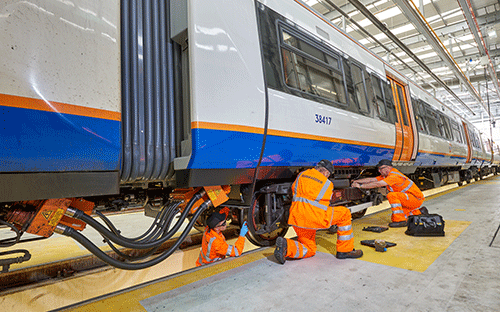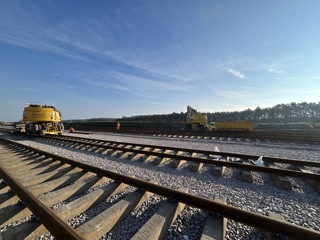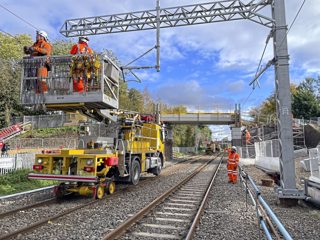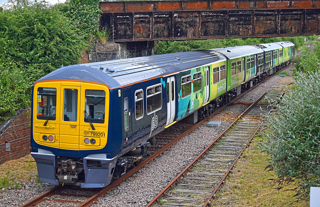Building trains at its Derby Litchurch Lane site is just one of many facets of Bombardier’s business in the UK.
Maintenance and engineering also feature heavily in the company’s portfolio. Today, contracts between train operating companies and manufacturers often encompass both train manufacture and maintenance, so having these capabilities ‘under one roof’ is a major asset for a supplier hoping to secure more deals.
Bombardier has been busy developing its Services portfolio to offer a range of complementary fleet management and maintenance packages to support its new trains. One such solution, which has been deployed to good effect at its Central Rivers depot is AVIS.
Martin Rennoldson, Group Account Director at Bombardier, explains: “AVIS stands for Automatic Vehicle Inspection System.”
The Central Rivers depot, located just outside Burton upon Trent, is home to the CrossCountry fleet of Class 220s and 221s, as well as Virgin Trains’ fleet of ‘221s’. These intercity trains were built by Bombardier in 2001/2002 and can be found running on routes from Scotland to the SouthWest, travelling as far north as Aberdeen, as far south as Bournemouth and as far west as Penzance.
The VT fleet runs from London Euston to Shrewsbury, Holyhead and Glasgow. These trains, like the XC fleet, cover huge distances per week and reliability is paramount for both train operating companies in maintaining acceptable service levels.
AVIS is a cost-effective train inspection system that supports condition-based maintenance. It can be used to inspect a range of train systems and components including brake pads, wheels, pantographs and collector shoes. The system delivers accurate information to Bombardier’s award-winning Orbita system to drive maintenance interventions and forward planning. Bombardier describes Orbita as “maintenance with intelligence”. It combines real time asset condition data with cross-fleet engineering knowledge to provide operational intelligence.
Orbita gathers data from Bombardier’s fleet knowledge and engineering expertise and is used to enhance the active management of vehicle maintenance, performance and operation. This has enabled Bombardier to move from a period-based maintenance regime to an approach whereby a significant proportion of maintenance tasks are condition-based. This, the company says, reduces unwarranted component replacements and means trains are out of traffic for a shorter period of time.
Through tools such as Orbita and AVIS – which combined form Bombardier’s AIMS (Asset Information Management Services) the trains themselves can be used as tools for monitoring operations and ultimately can provide data for fuel usage, passenger demand, delay analysis, infrastructure and environmental conditions. Analysing this data allows Bombardier to optimise fleet maintenance through the reduction of manual inspections, material usage and therefore cost. In addition, optimising both preventative and corrective maintenance activity through the use of condition based prognostic data improves availability and performance. Bombardier can also use AIMS to optimise fleet performance for energy management, smart stabling, energy metering, driver advisory services, monitoring environmental impact through track condition, overhead lines, weather and temperature. It can also analyse passenger loadings, assessing dwell times and examine congestion warnings.
Following the successful roll-out of AVIS at Central Rivers, Rennoldson says: “We are actively looking at using it on the London Overground.”
He says it is “very applicable” to the London Underground system as well.
“Over the next couple of years we’ll be making major investments to enhance our maintenance services for London Overground”. Rennoldson explains: “AVIS offers a major step towards automating some of the standard maintenance activities.”
Bombardier will shortly start similar work at its new Willesden depot, using lasers to monitor the condition of the new Class 710 trains and their components. “Central Rivers is a great example of how AVIS is making a difference. The technology is so accurate in measuring wheel wear that we’re getting more wheel life out of the fleet,” says Rennoldson. This, he says, creates a major cost saving. It also removes the chance of human error, and invariably provides a wealth of consistent/repeatable data at a more regular frequency than with manual inspection.
By monitoring wheel wear, and by using condition data alongside data from wheel lathes, other lineside condition-based maintenance systems (such as Gotcha® and RailBAM®), coupled with engineering analysis, Bombardier can optimise the point at which wheels are re-profiled to predict (and thus avoid) failures, and to ensure that excessive wheel flats across an entire fleet can be avoided. “This means that only necessary maintenance needs to be done to keep the fleet performing. And maintenance can be carried out at the right time, in a proactive manner, rather than reacting to something after it’s failed.”
“By monitoring and managing wheel wear, for example, you’re not only improving reliability, but you’re saving a substantial amount of money, because you’re not replacing the wheels as frequently. And when you are carrying out that work, you’re doing it in a far more measured and planned fashion.”
This really is a case of using ‘on-train’ and lineside ‘intelligence’ in terms of advising what maintenance is needed.
Rennoldson nods: “AVIS is not only an automatic inspection process. There is an automated interface with our Orbita monitoring system. Those two systems work together, so in the Central Rivers case you have a combined system that not only measures the wear of critical components, also recording visual indicators such as external pressure gauges, but also processes data taken from on-train systems, to (where necessary) trigger events and alerts. Therefore, using AVIS and Orbita as a combined system, the user can visualise fleet status and plan condition-based maintenance interventions. By looking at Orbita, the user can assess condition of all components ‘measured’ by AVIS and also check train condition related to train systems, looking at variables such as door opening times, traction motor power consumption etcetera. By using the knowledge gained from the retained data from the whole fleet, Orbita is programmed to assess and intercept ‘outliers’ before they cause service disruption. By using this information the user can schedule condition-based and corrective maintenance work, ensuring that performance is optimised while maintenance is executed efficiently and at the right time.”
Orbita combines the data gathered from rolling stock, AVIS and engineering expertise to enhance the active management of vehicles and infrastructure maintenance, performance and operation. This enables operators to proactively identify problems and convert data into meaningful information, which enables better maintenance planning. Quicker investigation times can significantly reduce operating costs and maximise fleet utilisation and availability.
Rennoldson affirms: “The key difference is that it is an integrated solution, so it’s no longer about someone sitting at a terminal determining that there is a problem, then filling in a work order on another system and finally sending it to the depot for attention. As soon as Orbita captures and identifies any data indicating system degradation, it generates an event or alert and, if necessary, it automatically generates a work order.
“London Underground remarked upon the level of automation when they visited Central Rivers. They had seen various elements of the system, but this was the first time that the entire system could be shown working as one. And that’s where, from an operator’s perspective the efficiency and the time to react is so much better. It means you can start to reduce operational costs. Plus you don’t need engineers or technicians to carry out basic inspections any more.”
Bombardier Head of Bids Engineering, Niall Simmons, expands on the implications of this: “This means existing staff can be deployed elsewhere. You can up-skill the workforce, deploy them to higher value activities, such as system diagnosis, rather than more routine tasks such as determining whether a wheel profile is compliant or not.”
Rennoldson says that these systems adhere to a predict and repair philosophy.
“This is the first time we’re taking this proven concept into London. It will mean a lot of work over the next couple of years.”
Is Bombardier looking to introduce these solutions into London because that’s where the major demand for enhanced reliability is? Rennoldson says London’s fleets in particular require “reliability and frequency, due to the exceptional levels of passenger ridership.’ Nevertheless he qualifies, as long as it can be justified due to fleet size and usage, there is a business case for it.”
Does this mean that trains are getting closer to diagnosing and engineering themselves? “Yes,” is Bombardier’s answer.
Rennoldson continues: “You don’t, in theory, need maintenance teams on site if a problem comes up - it can be remotely managed. This means that you can concentrate your efforts on an expertise in one or two key centres.
“While you will still have to send an engineer to fix things, sometimes the problem can be managed and circumvented remotely.”
Using these new systems, the train can tell the driver what is wrong (so that the driver can make a positive intervention), and remotely alert the train operator, or depot so that maintenance can be scheduled at the most appropriate time. Rennoldson says: “If the driver can fix the fault, or keep the train in service, then you end up with less dissatisfaction for passengers as well.”
The need for these systems is growing as the capital’s reliance on the railway grows.
London Underground Managing Director, Nick Brown, says passenger numbers on the Tube are higher than they were at the time of the 2012 Olympics. Now levels of ridership experienced on ‘Black Friday’ on November 27 2015, are the norm, yet passengers expect their trains to run consistently on time. It is up to the maintenance teams (in many cases in and around London supported by Bombardier staff), to ensure trains are service-ready.
Stratford, which played such an important function in the London 2012 Olympics, is now the tenth busiest station in the UK, with the Tube, the Docklands Light Rail, London Overground, TfL Rail, Abellio Greater Anglia and High Speed 1 all converging there. It also serves Westfield shopping centre and the City. Eventually it will serve Crossrail too. Says Rennoldson of Stratford: “It is a hub. Many businesses are planning to move near to it - it will become a hot bed of commerce and shopping.”
When it comes to developing rolling stock to serve the new hubs of London and in response to demand for more frequent and reliable train services across the city. Simmons advocates a team-based approach. As well as prognostic tools such as ORBITA and AVIS, which can ensure that trains run for longer between maintenance intervals, the rolling stock can be designed from the outset to minimise maintenance.
He explains: “We took a cross-functional team approach with the development of the Aventra platform, involving maintenance teams and key suppliers to ensure that the train was optimised from a maintenance perspective, which is now our standard approach to new train design. Getting the maintenance people, the manufacturing people and procurement staff all together in the same room makes it all so much more of a collaborative effort.”
This approach, combined with Bombardier’s innovative train management and prognostic systems, will ensure London’s railway is fit for the future. London is growing, and Bombardier is evolving to meet the demand.
- This feature was published in RAIL 793 on February 3 2016


















Andrewjgwilt1989 - 23/04/2016 00:51
I do like how Bombardier have built the DEMU Meridians for East Midlands Trains, Turbostar DMU's and Electrostar EMU's across the UK with the Aventra EMU's to be built for TfL MTR Crossrail and TfL London Overground and possibly more Electrostar and Turbostar trains to be built (like the Class 379 Electrostars for Abellio GA) and even Bombardier could win the contract to build the new London Underground rolling stocks for the Piccadilly and Bakerloo lines and possibly Central and Waterloo & City lines as they built the 2009 stocks for the Victoria Line and the S7 & S8 Sub Surface stocks (S-Stocks) for the Metropolitan, Circle, Hammersmith & City and District lines and new Docklands Light Railway rolling stocks for the DLR. Bombardier have built the most amazing trains for the UK and across Europe and Worldwide including North America aswell as they are Canadian based company.